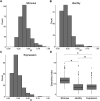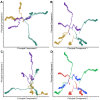Neuronal Population Encoding of Identity in Primate Prefrontal Cortex
- PMID: 37963766
- PMCID: PMC10860606
- DOI: 10.1523/JNEUROSCI.0703-23.2023
Neuronal Population Encoding of Identity in Primate Prefrontal Cortex
Abstract
The ventrolateral prefrontal cortex (VLPFC) shows robust activation during the perception of faces and voices. However, little is known about what categorical features of social stimuli drive neural activity in this region. Since perception of identity and expression are critical social functions, we examined whether neural responses to naturalistic stimuli were driven by these two categorical features in the prefrontal cortex. We recorded single neurons in the VLPFC, while two male rhesus macaques (Macaca mulatta) viewed short audiovisual videos of unfamiliar conspecifics making expressions of aggressive, affiliative, and neutral valence. Of the 285 neurons responsive to the audiovisual stimuli, 111 neurons had a main effect (two-way ANOVA) of identity, expression, or their interaction in their stimulus-related firing rates; however, decoding of expression and identity using single-unit firing rates rendered poor accuracy. Interestingly, when decoding from pseudo-populations of recorded neurons, the accuracy for both expression and identity increased with population size, suggesting that the population transmitted information relevant to both variables. Principal components analysis of mean population activity across time revealed that population responses to the same identity followed similar trajectories in the response space, facilitating segregation from other identities. Our results suggest that identity is a critical feature of social stimuli that dictates the structure of population activity in the VLPFC, during the perception of vocalizations and their corresponding facial expressions. These findings enhance our understanding of the role of the VLPFC in social behavior.
Keywords: expression; face; macaque; multisensory; prefrontal; vocalization.
Copyright © 2024 the authors.
Conflict of interest statement
The authors declare no competing financial interests.
Figures










Similar articles
-
Multisensory interactions of face and vocal information during perception and memory in ventrolateral prefrontal cortex.Philos Trans R Soc Lond B Biol Sci. 2023 Sep 25;378(1886):20220343. doi: 10.1098/rstb.2022.0343. Epub 2023 Aug 7. Philos Trans R Soc Lond B Biol Sci. 2023. PMID: 37545305 Free PMC article. Review.
-
Coding of vocalizations by single neurons in ventrolateral prefrontal cortex.Hear Res. 2013 Nov;305:135-43. doi: 10.1016/j.heares.2013.07.011. Epub 2013 Jul 26. Hear Res. 2013. PMID: 23895874 Free PMC article. Review.
-
Representation of Expression and Identity by Ventral Prefrontal Neurons.Neuroscience. 2022 Aug 1;496:243-260. doi: 10.1016/j.neuroscience.2022.05.033. Epub 2022 May 30. Neuroscience. 2022. PMID: 35654293 Free PMC article.
-
Responses of prefrontal multisensory neurons to mismatching faces and vocalizations.J Neurosci. 2014 Aug 20;34(34):11233-43. doi: 10.1523/JNEUROSCI.5168-13.2014. J Neurosci. 2014. PMID: 25143605 Free PMC article.
-
Neurons responsive to face-view in the primate ventrolateral prefrontal cortex.Neuroscience. 2011 Aug 25;189:223-35. doi: 10.1016/j.neuroscience.2011.05.014. Epub 2011 May 13. Neuroscience. 2011. PMID: 21605632 Free PMC article.
Cited by
-
Multisensory interactions of face and vocal information during perception and memory in ventrolateral prefrontal cortex.Philos Trans R Soc Lond B Biol Sci. 2023 Sep 25;378(1886):20220343. doi: 10.1098/rstb.2022.0343. Epub 2023 Aug 7. Philos Trans R Soc Lond B Biol Sci. 2023. PMID: 37545305 Free PMC article. Review.
-
Fast face-selective responses in prefrontal face patches of the macaque.Cell Rep. 2025 Mar 25;44(3):115389. doi: 10.1016/j.celrep.2025.115389. Epub 2025 Mar 6. Cell Rep. 2025. PMID: 40053452 Free PMC article.
-
Voice identity invariance by anterior temporal lobe neurons.Sci Adv. 2025 Aug 29;11(35):eadv7033. doi: 10.1126/sciadv.adv7033. Epub 2025 Aug 29. Sci Adv. 2025. PMID: 40880484 Free PMC article.
-
Neuronal Mechanisms Underlying Face Recognition in Non-human Primates.Jpn Psychol Res. 2024 Oct;66(4):416-442. doi: 10.1111/jpr.12530. Epub 2024 Jun 10. Jpn Psychol Res. 2024. PMID: 39611029
References
Publication types
MeSH terms
Grants and funding
LinkOut - more resources
Full Text Sources
